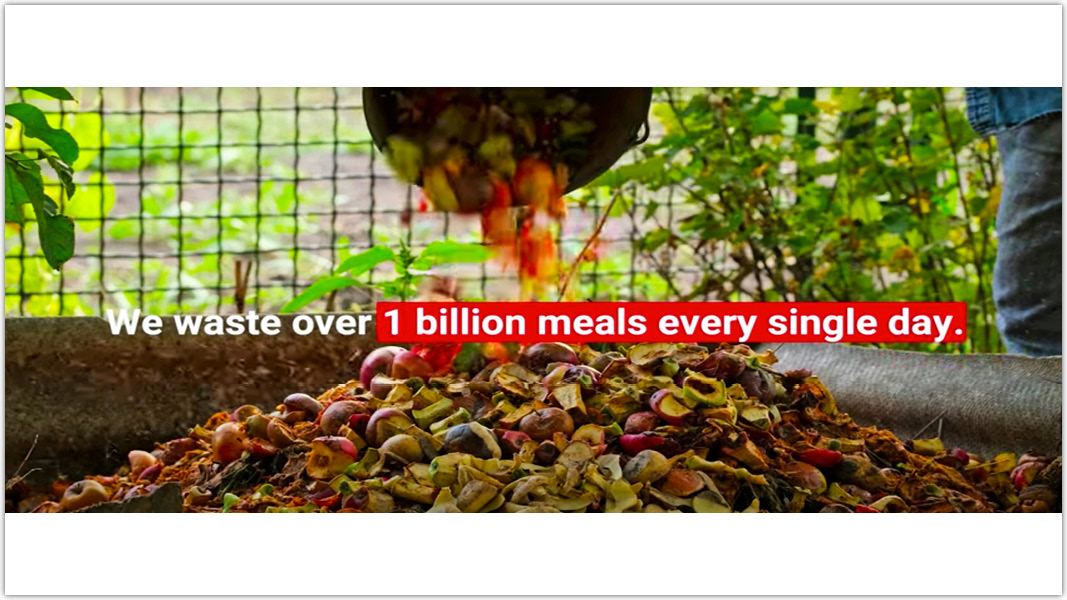Top: The amount of food that households waste is the equivalent of 1.3 meals every day for everyone in the world impacted by hunger. Image courtesy UN Environment Programme
The United Nations Environment Programme’s (UNEP) 2024 Food Waste Index Report tracks country-level progress to halve food waste by 2030 (Sustainable Development Goal 12.3). First published in 2021, the current report (2022 data) builds on recent and greater datasets and provides an update on the scale of food wasted worldwide. In 2022, the world wasted 1.05 billion metric tons (1.16 billion tons) of food — amounting to one-fifth (19%) of food available to consumers being wasted at the retail, food service, and household levels. That is in addition to the 13% of the world’s food lost in the supply chain, as estimated by the UN’s Food & Agriculture Organization (FAO), from post-harvest up to and excluding retail. Key messages in UNEP’s 2024 Index report include:
- Most of the world’s food waste comes from households. Out of the total food wasted in 2022, households were responsible for 631 million metric tons, equivalent to 60%. The food service and retail sectors’ portion were 421 million metric tons, or 40% (290 and 131 million metric tons, respectively). In the U.S., based on U.S. Environmental Protection Agency data (2019), the percentages are flipped, with 40% of the 66.2 million tons of wasted food generated by households, and 60% from food service and food retail.
- Reducing food waste provides compounding benefits. Food loss and waste generates 8% to 10% of global greenhouse gas (GHG) emissions — almost five times the total emissions from the aviation sector. It occurs while 783 million people are hungry and a third of humanity faces food insecurity.
- Households waste at least one billion meals a day. On average, each person wastes 79kg of food annually therefore the equivalent of at least one billion meals of edible food is being wasted in households worldwide every single day, using a very conservative assessment on the share of food waste that is edible. This is the equivalent of 1.3 meals every day for everyone in the world impacted by hunger.
- Food waste is not just a “rich country” problem. Following a near doubling of data coverage since the 2021 Food Waste Index Report was published, there has been increased convergence in the average per capita household food waste. High-income, upper-middle income, and lower-middle income countries differ in observed average levels of household food waste by just 7 kg/capita/year.
- Countries such as Japan and the UK show that change at scale is possible, with reductions of 18% and 31% respectively. Governments, cities, municipalities, and food businesses of all sizes should work collaboratively to reduce food waste and help householders to act.
The potential of these collaborations is illustrated by just-released data from ReFED and the Pacific Coast Food Waste Commitment in the U.S., the public-private partnership between food businesses and jurisdictions on the West Coast to cut food waste in the region. The analysis shows that over the three-year period from 2019 to 2022 (the latest year for which data is available), grocery retailers decreased the number of tons of unsold food in their regional operations by 25% — nearly 190,000 tons of food valued at $311 million — which represents a decrease in the amount of food at risk of going to waste. The data also shows a 20% increase in the rate of unsold food being donated and a 28% increase in the rate of unsold food getting composted. Another significant takeaway is that the three-year decline in unsold food led to an estimated 30% decrease in the total carbon footprint of unsold food in the region. ReFED is hosting a special webinar on these findings on April 16.













